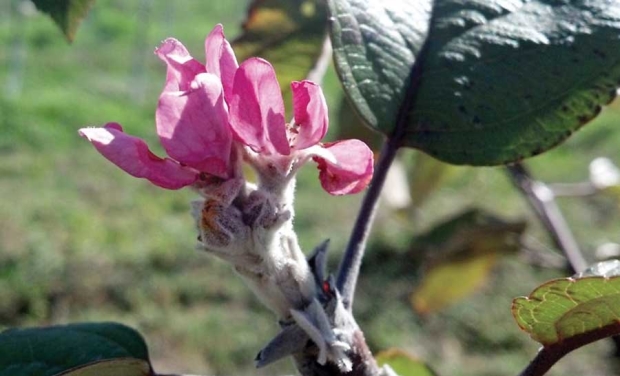
Blooms on apple trees in September? That’s what some growers in Michigan reported last fall — an oddity, but not a major cause for alarm, according to Michigan State University Extension fruit educator Mark Longstroth. Nonetheless, growers can curb the inappropriately timed apple blossoms.
Longstroth estimated that autumn apple blooming occurs about every four to five years in Michigan, and it also occasionally happens on plums, cherries and other trees. Scattered reports came primarily from apple growers in the southern part of the state last fall, although he did hear of fall bloom on cherry trees, too.
Fall blooms cut back on the following year’s yield, Longstroth said, but it’s probably not significant for a couple of reasons: First, only some buds on a tree will bloom early. Second, growers will thin fruit after this spring’s bloom anyway.
“With apples, we normally want 75 percent of the flower spurs to bloom in the spring, but then we thin the fruit off 80 percent of those, so we end up with only about 10 percent of the fruit — the big-sized apples that we want to sell — at harvest,” he said.
In other words, although fall blooming does indeed take those buds out of the following year’s apple production cycle, most growers will ultimately notice little if any difference in yield.
The fall blooming in Michigan can be traced to last year’s weather pattern, he noted. Michigan had a very wet spring, which means that there was abundant water, so the trees grew rapidly but didn’t have to grow a lot of roots.
The wet conditions allowed the trees to sprout new white roots in the shallow surface soil rather than across a big root system to draw up water from deep in the ground.
At the same time, the wet conditions allowed the tree to put out lots of leaves but with less of the waxy, outer cuticles that protect against water loss.
That water-rich June, however, was followed by a hot and dry July. “That just sucked all the water out of the trees, so they had to shut down for a little while until they could grow more roots,” he said.
Buds generally develop by late summer, after which they should develop an inhibition to blooming until they go through a winter chilling.
“What we think happened this past fall is that the drought stress caused the trees to stop growing, but when we got rain in September and the trees started growing again, some of the flower buds were far enough developed to have all of their flower parts, but weren’t far enough along to have developed the inhibition that would have kept them from blooming until they had gone through a winter,” he said. “Those buds are the ones that bloomed in the fall.”
While the fall-blooming buds are removed from apple production the following year, he doesn’t believe the tree itself sustains any damage.
“In the area of where the blossoms are, it would reduce winter hardiness, but you’re never going to mature that fruit anyway, so it’s not going to have a big impact on the overall winter hardiness of the tree,” he said. “In fact, growers can have a much bigger negative impact on winter hardiness through their pruning activities in the fall, but that’s a whole other article!”
Generally, fall blooming doesn’t compromise the tree or the harvest much, but growers can still do something to help ensure that it doesn’t happen to their trees in the future. “To reduce the likelihood of fall bloom, you should try to maintain good moisture content in the soil.
Don’t let the trees get drought-stressed in the midsummer if you can help it,” Longstroth said.
Whereas growers in the West typically use irrigation to maintain even soil moisture, those in Michigan often rely on Mother Nature, so they need to monitor rainfall and provide supplemental water if a midsummer drought sets in.
“I’ve been working in apples and other fruit trees since 1978, and in that time I’ve seen fall blooming a half-dozen times,” he said. He doesn’t think it’s becoming more common or is related to climate change, but he is pretty sure he will hear from growers in a few years when September apple blossoms appear again. •
Online
For more on fall blooming, see Michigan State University Extension fruit educator Mark Longstroth’s article on the subject at bit.ly/1RnnYBr
—by Leslie Mertz






My trees are here in Georgia. I not only have flowering, The fruit is hanging now. 10/31/16
i live near Lexington NC and planted a Cortland and a Red Delicious apple tree this spring i only had to water a time or to we got a lot of rain early but August was dry for the most part and September has been dry. My Cortland is blooming now is this OK?
My Apple tree is blooming September 6 very strange
Thank you for the information. I’m located in Northern Oklahoma and the weather pattern you explained is exactly what happened here this year with the added stress of my neighbor spraying soybeans and killing all the leaves. I thought they were dead and gave up on watering them in our late July early August dry spell. The rain came down and the trees started growing new leaves I noticed last week. Today August 23, I have blooms on them. I admit I don’t know anything about raising apples. I just scored 10 trees on clearance at Walmart. I’m pretty sure I lost 3 due to chemical damage. Any tips on fertilization and pest management practices?
A few blooms seen on 9/16/2022 in Central Ohio. Interesting as that most of the leaves dropped off starting in August, which is a new condition.
Blooms on a gala in Central Ohio within the last week.